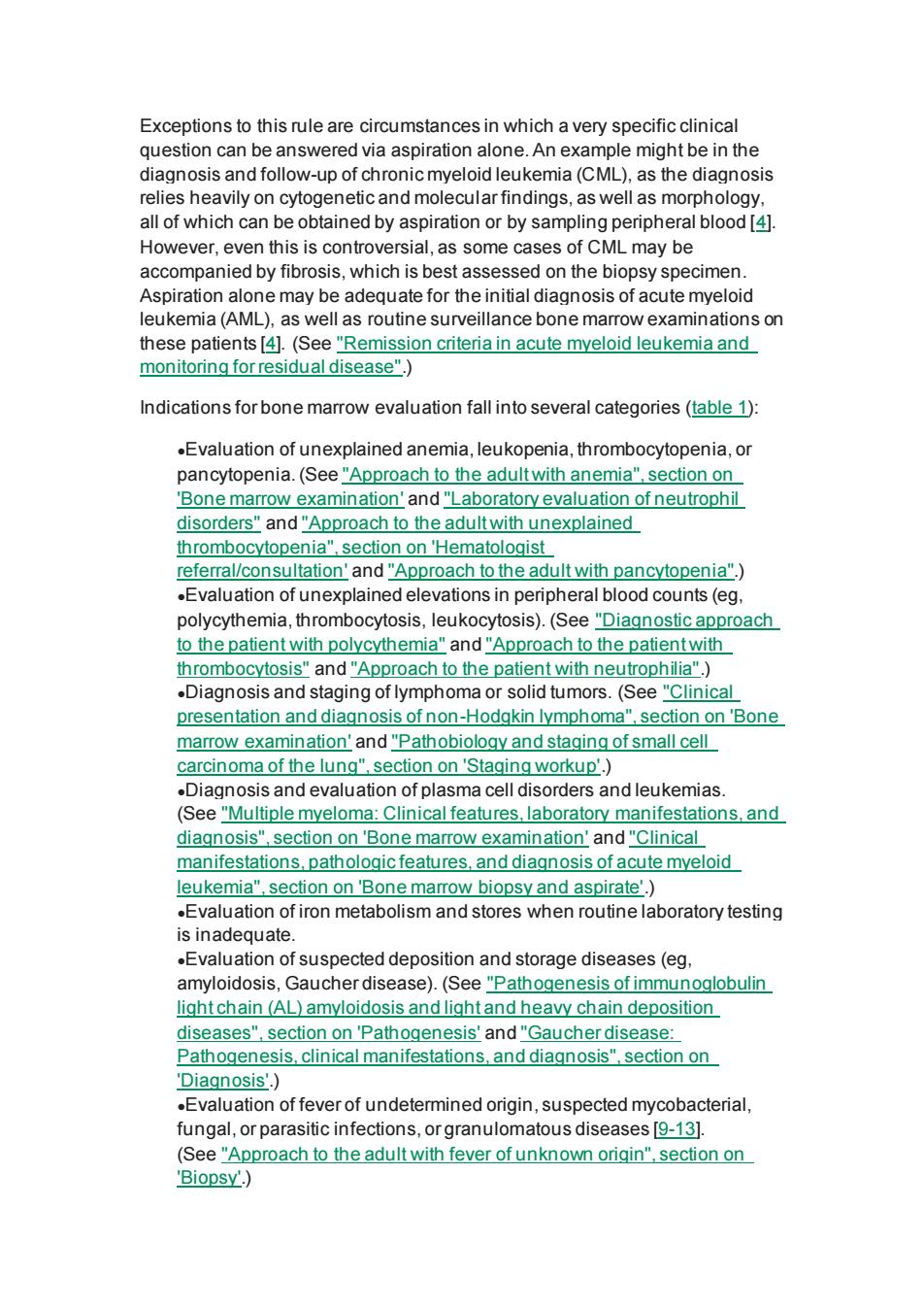正在加载图片...

Exceptions to this rule are circumstances in which a very specific clinical might be in the question.can beanswered via aCMin nle diagnosis and follow-up of chron relies heavily on cytogenetic and molecular findings,as well as morphology. all of which can be obtained by aspiration or by sampling peripheral blood [4] However.even this is controversial.as some cases of CML may be accompanied by fibrosis,which is best assessed on the biopsy specimen e may be ate for the initial diagnosis of acute leukemia(AM )as well as routine surveillance b one marrow ex aminations on these patients [41.(See "Remission criteria in acute mveloid leukemia and monitoring for residual disease".) Indications for bone marrow evaluation fall into several categories(table 1) .Evaluation of unexplained anemia,leukopenia,thrombocytopenia,or pancytopenia.(See"Approach to the adult with anemia"section on 'Bone marrow examination'and"Laboratory evaluation of neutrophil disorders"and"Approach to the adult with unexplained thrombocytopenia"section on 'Hematologist referral/consultation'and"Approach to the adult with pancytopenia") Evaluation of unexplaine elevations in peripheral blood polycythemia,thrombocytosis,leukocytosis).(See"Diagnostic approach to the patient with polycythemia"and"Approach to the patient with thrombocytosis"and"Approach to the patient with neutrophilia".) .Diagnosis and staging of lymphoma or solid tumors.(See "Clinical presentation and diagnosis of non-Hodgkin lymphoma"section on'Bone marrow examination'and"Pathobiology and staging of small cell carcinoma of the lung",section on'Staging workup'.) .Diagnosis and evaluation of plasma cell disorders and leukemias. (See "Multiple myeloma:Clinical features,laboratory manifestations,and diagnosis",section on'Bone marrow examination'and"Clinical manifestations pathologic features.and diagnosis of acute myeloid leukemia",section on'Bone marrow biopsy and aspirate'.) Evaluation of iron metabolism and stores when routine laboratory testing is inadequate .Evaluation of suspected deposition and storage diseases(eg amyloido aucher dis ease ee "Pathogenesis of immunoglobulin light chain (AL)amyloidosis and light and heavy chain deposition diseases",section on 'Pathogenesis'and"Gaucher disease: Pathogenesis,clinical manifestations,and diagnosis"section on Diagnosis') .Evaluation of fever of undetermined origin,suspected mycobacterial fungal,or parasitic infections,or granulomatous diseases [9-13]. (See "Approach to the adult with fever of unknown origin",section on 'Biopsy.) Exceptions to this rule are circumstances in which a very specific clinical question can be answered via aspiration alone. An example might be in the diagnosis and follow-up of chronic myeloid leukemia (CML), as the diagnosis relies heavily on cytogenetic and molecular findings, as well as morphology, all of which can be obtained by aspiration or by sampling peripheral blood [4]. However, even this is controversial, as some cases of CML may be accompanied by fibrosis, which is best assessed on the biopsy specimen. Aspiration alone may be adequate for the initial diagnosis of acute myeloid leukemia (AML), as well as routine surveillance bone marrow examinations on these patients [4]. (See "Remission criteria in acute myeloid leukemia and monitoring for residual disease".) Indications for bone marrow evaluation fall into several categories (table 1): ●Evaluation of unexplained anemia, leukopenia, thrombocytopenia, or pancytopenia. (See "Approach to the adult with anemia", section on 'Bone marrow examination' and "Laboratory evaluation of neutrophil disorders" and "Approach to the adult with unexplained thrombocytopenia", section on 'Hematologist referral/consultation' and "Approach to the adult with pancytopenia".) ●Evaluation of unexplained elevations in peripheral blood counts (eg, polycythemia, thrombocytosis, leukocytosis). (See "Diagnostic approach to the patient with polycythemia" and "Approach to the patient with thrombocytosis" and "Approach to the patient with neutrophilia".) ●Diagnosis and staging of lymphoma or solid tumors. (See "Clinical presentation and diagnosis of non-Hodgkin lymphoma", section on 'Bone marrow examination' and "Pathobiology and staging of small cell carcinoma of the lung", section on 'Staging workup'.) ●Diagnosis and evaluation of plasma cell disorders and leukemias. (See "Multiple myeloma: Clinical features, laboratory manifestations, and diagnosis", section on 'Bone marrow examination' and "Clinical manifestations, pathologic features, and diagnosis of acute myeloid leukemia", section on 'Bone marrow biopsy and aspirate'.) ●Evaluation of iron metabolism and stores when routine laboratory testing is inadequate. ●Evaluation of suspected deposition and storage diseases (eg, amyloidosis, Gaucher disease). (See "Pathogenesis of immunoglobulin light chain (AL) amyloidosis and light and heavy chain deposition diseases", section on 'Pathogenesis' and "Gaucher disease: Pathogenesis, clinical manifestations, and diagnosis", section on 'Diagnosis'.) ●Evaluation of fever of undetermined origin, suspected mycobacterial, fungal, or parasitic infections, or granulomatous diseases [9-13]. (See "Approach to the adult with fever of unknown origin", section on 'Biopsy'.)